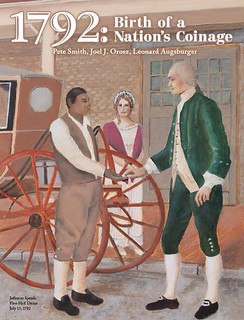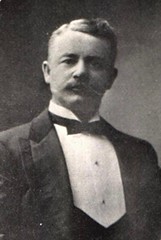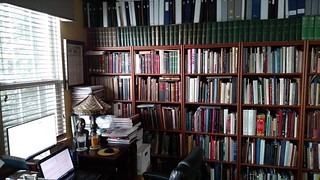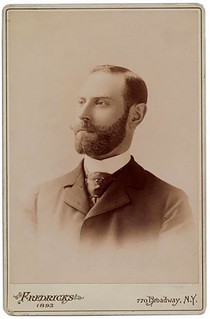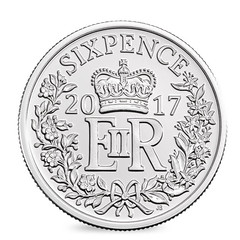
PREV ARTICLE
NEXT ARTICLE
FULL ISSUE
PREV FULL ISSUE
NOTES FROM E-SYLUM READERS: MARCH 5, 2017 New 1792 Book Available for Viewing at ANA A copy of 1792: Birth of a Nation’s Coinage will be available for viewing at Rich Uhrich’s table (#1017) at the American Numismatic Association National Money Show in Orlando (March 9-11, 2017). Written by Pete Smith, Joel Orosz, and Len Augsburger, this book presents an in-depth examination of the United States coinage of 1792, including a comprehensive census of all known examples. Ordering details will be released by Heritage in the near future.
This highly-anticipated book has been many years in the making.
Be among the first to see it!
-Editor
Orloff Printing Process Question 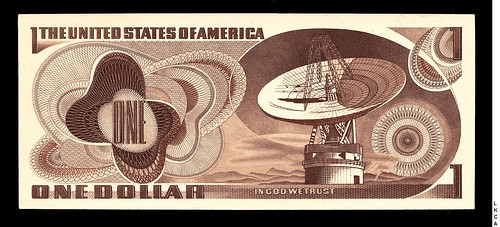
Regarding author Gene Hessler's response last week about the multi-intaglio or 'Orlof intaglio' banknote printing process, E-Sylum reader Bob Leuver of Maryland writes: Gene's note makes it sound as if the Orloff printing method originated with De la Rue Giori. As I recall, the Orloff method of gravure/intaglio was used by Russia for banknotes. I researched the printing method with Alberto Albinati, Giori's top salesman. We discussed whether it would enhance their presses. I have forgotten just about everything I knew about the Orloff method, so my comments are not a criticism. Perhaps, Gene could enlighten me. I retired from the BEP 29 years ago, so there.. Gene Hessler writes: Regarding the Orloff press, I know it was registered in 1897, but interpreted Prof. Hellmann's comment about this press as being a hybrid. Prof. Hellmann was in his last years when he provided this information. By the way, my U.S. Essay Proof & Specimen Notes that was illustrated is the 2nd edition.
Thanks, everyone.
-Editor
To read the earlier E-Sylum article, see:
More on Ralph Barker
My catalog of the sale 08/13/1902 is a prize. It is Barker's personal copy. It has the lots of his consignment priced. Totals show with a 25% commission deducted. The next sale was on 07/07/1904. and the last 11/28/1913, held after Barker's death. I just obtained that one in the recent Charles Davis sale.
Thanks. I was glad to see this bio - Barker is not a numismatic figure I was familiar with.
-Editor
To read the earlier E-Sylum article, see:
On Arabic Numeral Dates There was found on the bank of the Ohio river, and is now in the possession of the Doctor A.D. Keith of this place, an old Roman coin, made of copper, bearing a Latin in- scription with the title of Nova Caesarae and purporting to have been coined as early as the year 787. It is something remarkable that it has not wasted more than appears; the impression of a horse's head with a plough and shield is quite plain; the letters appear to be well formed. Martin Purdy writes: This attribution of Arabic numerals to a period before they were in use in the West reminds me a little of an item that was on display in a private museum here in New Zealand some years ago. Supposedly a Roman coin from "A.D. 515" , its date caught my eye as being both a little too late and a little too precise. I asked for a closer look and it turned out to be a Constantinian copper of a couple of centuries earlier, with the mintmark SIS (= Siscia, now Sisak in Croatia) in the exergue! Close, but no cigar.
Thanks. Somewhat more plausible than coins dated "B.C.", but incorrect nonetheless. Thanks for setting them straight.
-Editor
Martin adds: As far as I can tell, they started in India (so not really "Arabic" at all) around the 4th century, then reached the Arab world around the 8th century, from where we picked them up around the 12th - but it took another couple of hundred years for them to get into any form of widespread use and for their shapes to become standardized, and probably another couple of hundred years again for them to start supplanting Roman numerals - quite a fascinating field for study in itself!
To read the earlier E-Sylum article, see:
Library Organization, Or Lack Thereof
In a way it is reassuring to discover that I am not alone. (I trust that these books are not double shelved, i.e., that there is not a second row of books behind the visible ones. In the 1980s I visited Leroy ["Jim"] Kaczor in Champaign, a wonderful person, and I noticed that his car was parked in the driveway, though he had a garage. I was looking to buy a copy of an ANS publication and thought he might have one, since he was a long-time member of the ANS. We went out to the garage, and I found that the walls were covered with bookshelves and there were library tables in the middle. The tables were heaped with numismatic books. Checking the shelves, I found that there were books behind those in front. And he lacked the book I wanted!)
Actually, there are books stuffed behind books. Someday the whole thing may explode and bury me in a pile of biblio-debris.
At least it would be a fitting end for a bibliophile.
-Editor
To read the earlier E-Sylum article, see:
Quick Quiz: Who Is This Mystery American Numismatist?
I found a city directory of a clerk with that last name living at that address. I learned that he moved to a new city and got involved selling stomach bitters. One of his bitters bottles would be a treasure to a bottle collector. Can any E-Sylum reader identify this numismatist? Can any E-Sylum reader identify another numismatist that crosses into the field of bottle collecting?
Great questions. Any guesses on who Pete's Mystery Numismatist is?
-Editor
A Mystery Shakespeare Token 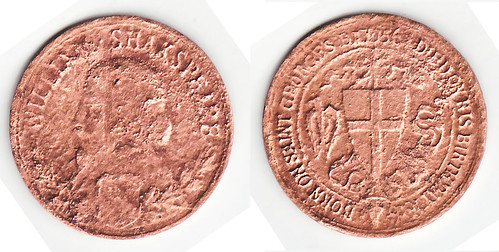
Philip De Jersey writes: I was interested to read the piece on Shakespeare medals in the latest E-Sylum. Amongst a group of metal-detected finds bought to me last week was this copper alloy token (19mm, 1.71g), with WILLIAM SHAKSPEARE on the obverse and BORN ON SAINT GEORGE’S DAY 1564 DIED ON HIS BIRTHDAY 1616 on the reverse. There is a somewhat similar obverse on a much heavier pewter medal at https://finds.org.uk/database/artefacts/record/id/606993, issued in 1916, which provides the only parallel I have been able to find on the web. It could be that this token is local to Guernsey, in the Channel Islands, where it was discovered, but I’ve found no mention of such an object in the standard numismatic sources for the islands, and we have no comparable items in our museum collection. Any observations or suggestions of origin would of course be welcome…
Can anyone help?
-Editor
To read the earlier E-Sylum article, see:
The Minting of Sixpence Coins
Of course, these new sixpences aren't intended for circulation but are designed for collectors, and to be given as gifts. They sell them for £30.00. According to the Royal Mint, "The silver sixpence has long been a token of good luck, popped into Christmas puddings and the shoes of brides fulfilling the traditional rhyme ‘Something old, something new, something borrowed, something blue and a silver sixpence in her shoe’."
Thanks.
-Editor
To read the earlier E-Sylum article, see:
Timeless Rittenhouse Has anyone mentioned the television show “Timeless”? It is a show about time travel. Briefly, there are two time machines – one is piloted by a man who wants to change historic events in an attempt to erase the recent death of his wife and daughter. The other is piloted by a team dedicated to stopping him from screwing up history. But here’s the kicker/slight numismatic nugget, they are both being manipulated by an evil entity known as ‘Rittenhouse’, and yes, this evil empire was founded by David Rittenhouse, who incidentally, is depicted as a psychopathic monster who covertly controls the country. They never mention his pulling the strings at the U.S. Mint, and he is shot to death in episode 10, but his maniacal followers are still ‘controlling’ us presently! Hmm, isn’t there a group of numismatists who call themselves “The Rittenhouse Society”? Just what are you folks up to?? I find the program somewhat entertaining, though redundant.
Sorry, Jeff. I'm afraid now we'll have to have you killed. Actually, one of the Rittenhouse Society members mentioned this show the other day; I haven't seen it. Time travel is always a great excuse for a plot. Who wouldn't love the opportunity to travel though time to save the world, even the score with an old bully, kiss that girl, or just get rich? Founded in 1957 and named for scientist and first Director of the U.S. Mint David Rittenhouse, the Rittenhouse Society is a small group that meets once a year for breakfast at the annual American Numismatic Association summer convention. We're all numismatic researchers and writers, and with all our projects no one has time to control the world. We may have a few geniuses, but no one's evil. -Editor Authenticating Odd & Curious Money I've always been oddly curious about odd & curious money. Can these crude items ever be truly authenticated as having been used as money? Bob Leonard writes: Check your copy of Curious Currency, or Quiggin, who I quoted. Curious Currency, p. 82, footnote 37, citing Quiggin, A Survey of Primitive Money, pp. 77-79. A couple of citations from Quiggin: "Cameron, crossing over lake Tanganyika ...in 1874, found that his trade-beads...were of no further value and he had to use the Urua crosses, here called handa. These were larger than the average type, 15 to 16 inches..." (Quiggin, p. 78, citing Cameron, 1877, I, p. 319). Quiggin mentions some prices in terms of Katanga crosses: a gun, 10, and 4 fowls or a fathom of cloth, 5. In 1924 bride-price was 14 large crosses, a large she-goat, a piece of indigo drill (a kind of cloth), and a female slave (yes, slavery had not yet been abolished in Africa then). On p. 79 is the divorce anecdote I quoted, though I switched the order of items returned for better effect.
To read the earlier E-Sylum articles, see:
Shaving In the Old Treasury Vault I reckon he's most likely shaving - note the white patch on his face, and the fact that the guy at rear top right is holding a mirror in the right position for him! See attached detail, with brightness/contrast slightly tweaked.
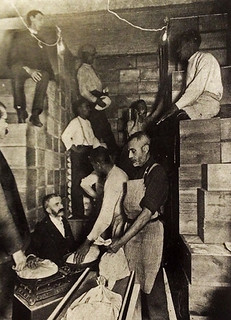
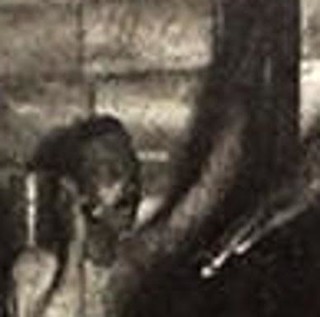
Well I'll be! That DOES look like he's shaving.
It's a staged photo and he's likely doing that for fun to see who'd notice.
-Editor
To read the earlier E-Sylum articles, see:

Wayne Homren, Editor The Numismatic Bibliomania Society is a non-profit organization promoting numismatic literature. See our web site at coinbooks.org. To submit items for publication in The E-Sylum, write to the Editor at this address: whomren@gmail.com To subscribe go to: https://my.binhost.com/lists/listinfo/esylum All Rights Reserved. NBS Home Page Contact the NBS webmaster 
|
